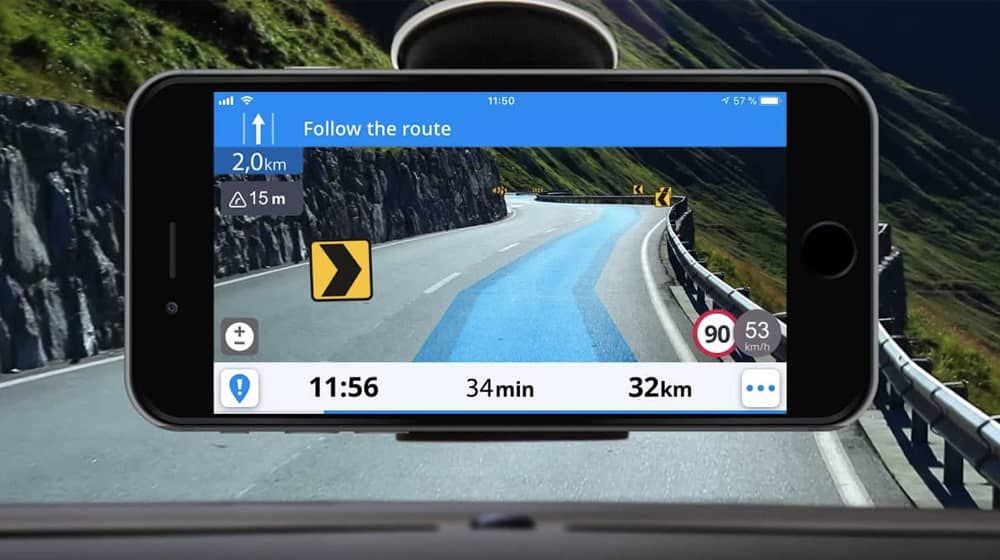
Augmented Reality Navigation Systems
Placed on or even integrated into the windshield, AR Navigation systems can seriously improve the driving-experience. A phone or a dedicated screen in the windshield would display directions, speed limits, and traffic warnings right on the road. The same could also work with AR goggles. And not just in the car, pedestrians could use a similar smartphone app just as well.

Benefits
Perhaps the biggest and most apparent benefit is safety. Having directions shown on the road is perfect since this where the driver is supposed to look. Plenty of accidents happen because drivers are checking their phone for directions.
- Improved Understanding: AR provides visual cues that overlay the real environment, making it easier to understand complex routes and directions.
- Real-time directions: Directions and navigation aids can be updated in real time.
- Safety: Users can navigate while keeping their eyes on their surroundings, which is particularly beneficial for pedestrians and cyclists.
- Contextual information: Information about points of interest, restaurants, and historical facts can be displayed.
- Points of interest: Instead of relying solely on maps, AR highlights points of interest in real time.
- Accessibility: AR can help people with disabilities by providing audio and haptic feedback in addition to visual cues.
- Hands-free operation: With devices such as AR glasses, users can receive navigation assistance without holding a device.
- Indoor Navigation: AR can help with indoor navigation in areas where traditional GPS-based systems are ineffective, such as shopping malls, airports, and large office buildings.
- Travel: Tourists can engage more with their surroundings by using AR navigation.
- Professional use: In industries such as logistics, construction, and emergency services, AR can show the most direct routes in complex environments.
- Personalization: AR navigation systems use artificial intelligence to learn from user preferences and behavior and suggest personalized routes.
Challenges
Colorful and unnatural icons on the road might be just as distracting as they might be helpful. In the end, this technology has to be very refined before being useful and safe. If the tracking doesn't work flawlessly, drivers might get guided off of the road, for example.
Take away
Driving and traffic are sensitive topics, as they always deal with severe safety risks. AR navigation systems could improve safety on our streets, but they could also do the exact opposite. There will probably come a lot of solutions as soon as AR glasses are more widely available and used.
Examples
Sygic’s AR Addon
Sygic offers a paid AR add-on for their smartphone car navigation app.
Mercedes-Benz MBUX Augmented Reality (AR) Navigation
A highlight of the Mercedes-Benz User Experience (MBUX) system, MBUX Augmented Reality Navigation is a great example of augmented reality. It makes navigation more intuitive, accurate, and stress-free by combining real images with digital navigation.
Live Video Transmission
A front camera captures high-resolution, real-time video of the road ahead. These videos are displayed on either the central touchscreen or the digital instrument panel.
Digital overlays
The MBUX system displays important navigation information directly on the live image. This includes, for example:
- Arrows that precisely show the route
- Street names and house numbers
- Traffic light status
It also displays sights and other significant landmarks.
Technical aspects
- Front camera: Captures a live feed of the road.
- Sensors and CPU: Collect and process environmental data to ensure that the overlays match the real world accurately.
- Head-up Display (HUD): Displays AR navigation data with overlays on either the main screen or the windshield.

Founder and CEO
Passion for New Technologies
As a creative engineer and consultant specializing in holistic digital transformation, I have spent over 15 years helping renowned companies use new and innovative technologies in creative and meaningful ways.
At "The Spatial Studio," my team and I combine engineering expertise, software development, and UX design to create entirely new three-dimensional possibilities for our clients.
